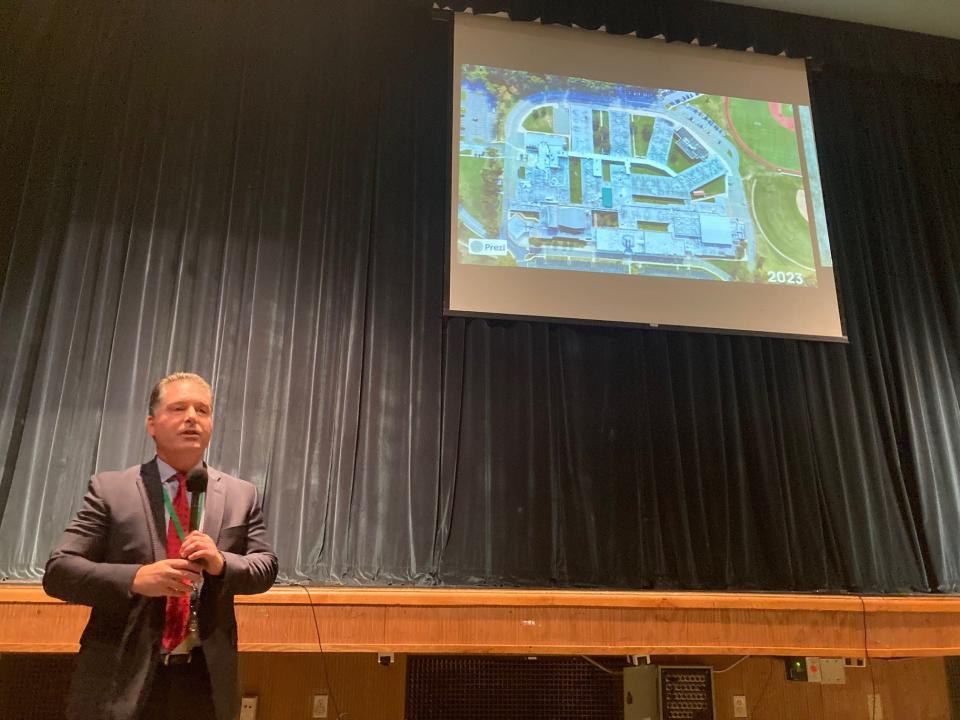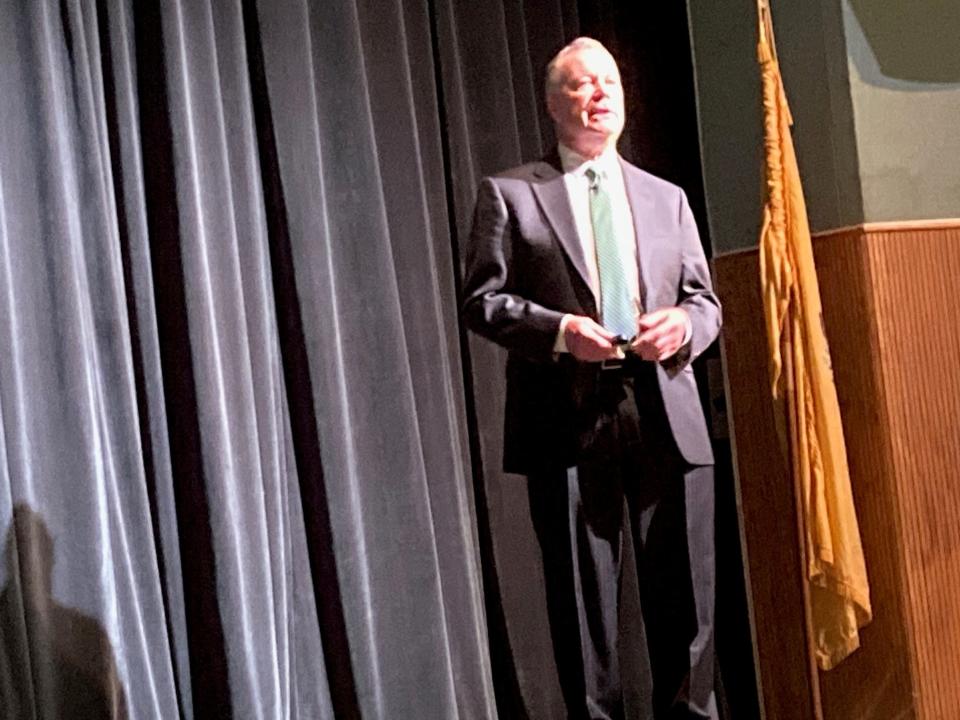The future of East Brunswick High School may cost up to $480 million: superintendent
EAST BRUNSWICK – Under an "Envisioning Big Things" theme, nearly 200 residents turned out earlier this week for a Community Forum at East Brunswick High School to provide feedback for the future of the school.
With two possibilities on the table, renovating the 60-plus-year-old building or building a new high school with a price tag estimated around $480 million, according to the superintendent, administrators and school board members hope input from residents will better direct them to a model that would best suit the district.
Reasons given for the necessity of either a new build or renovation include an aging facility, current space constraints, logistical concerns and operational issues, according to school officials.
Currently, about 2,100 grades 10-12 students attend the high school on an A/B block schedule averaging 82 minutes each.
Community feedback requested by the district
After a presentation in the high school auditorium by Superintendent of Schools Victor Valeski and East Brunswick High School Principal Michael Vinella, attendees filed out questionnaires and toured the building.
"Tonight was information gathering," Valeski said. "We owe this community a cost of either the renovation or a new school in whatever way the board decides to do. We will be transparent about what we collect tonight. It will be shared with the community and will have a spot on our website where you will see what people tonight said, how they gave their feedback."

After taking a tour of the school, Charlie and Sari Hitchins agreed the facility "definitely needs upgrades." They hope a timeline could benefit at least one of their daughters, now in sixth and eighth grades, if not both.
"I personally think I'm more in the camp of knocking this building down and building up for the future," said Charlie Hitchins. "The initial building’s over 60 years old. Times have changed, needs have changed. And it is a changing population in East Brunswick. Having those new facilities, whether it's a new science lab, new media lab, new athletic facilities, it will just make East Brunswick more appealing to the next generation coming in."
Concerns for a building more than 60 years old
Ground was broken for the high school in 1957, with the school opening for the 1958-59 school year. Designed in a "California" style, the original building comprised of a series of seven freestanding pavilions connected by open breezeways.
Throughout the years, the school has undergone a variety of additions and redesigns that have connected most of the original buildings. The last major renovation took place in 2001. This included a second level of classrooms, over the administrative offices, a corridor connecting three halls that had previously been connected only by a covered outdoor walkway, a proper main entrance, and expanded facilities for the cafeteria, library, arts and athletic departments.
Right now, Valeski said, "we see it as a facility that is in need of attention or replacement."
In October, the high school was closed for seven days due to a water main break under the building. Students reverted to virtual sessions during the repair. This highlighted the need for action to be taken sooner rather than later, Valeski said.
Earlier: East Brunswick BOE challenges mayor's 'nonsense' about new high school
"For everyone who owns property or a house in East Brunswick, undoubtedly an improvement at the high school, no matter which way the board or the community wants to go, is going to generate increased potential value for every single homeowner, and then I'm going to ask you to consider what's the cost of doing nothing," Valeski said. "If we continue to defer this decision, what's the cost of not doing something? Because there is a cost to that and as you've seen with the repair to the high school, the cost of that repair wasn't just monetary. It was seven days that students weren't in school."
According to Vinella, the principal, along with issues of overcrowding and physical challenges, the high school is not reflective of how learning takes place in the 2020s.
"We're empowering the students to be the center of the learning environment," Vinella said. "And this infrastructure really does not support that. The opportunity for collaboration across departments is where curriculum and learning is going. We have one of the best staffs in the state of New Jersey. I'm really honored to work with them. And they make excellence come alive. But they could do so much more. And if you take a look at the new standards that they're requiring us to teach, this current learning environment is not conducive to that."

The prospect of a high school project has been in discussion in school board committees since before the pandemic, which put a pause on the effort.
Last year, school board and community members of an ad hoc committee looked at the feasibility of replacing East Brunswick High School with a completely new, grades 9-12 facility as compared to moving the ninth grade to the high school and renovating the entire facility in multiple stages. The findings of the committee were presented to the school board earlier this school year.
A tax levy is a major concern for residents
For residents, a primary concern is the tax levy they will bear for the millions of dollars either project will cost.
Amr Eldessouky, who attended with his wife Kholod Ziada, found the forum "very informative." The couple has six children, two who graduated from the high school and four who are attending district schools.
"They tried their best to clarify possible plans and asked our input to make decisions based on what the community wants," Eldessouky said. "But, of most importance is what will the tax implication be for the residents. We are known for our excellent school system, but we also are already known for high property taxes."
"It's obvious the cost is going to be a concern for anybody," Charlie Hitchins said. "What will the taxes be added on to our bills. Our bills are high. But if you're looking at a new facility and you're looking at helping the next generation, I'm in the camp that you need to do this. This is where you need to invest. You don't need to invest in like necessarily a new park. You need to invest in kids in the future. And how you do it − you build new facilities."
According to Valeski, more information regarding any tax increase impacting residents will be known sometime in the spring. As plans are still in early stages, the next step will be a presentation about the collected resident input at an upcoming school board meeting.
The Board of Education will make the decision concerning a new build or a renovation, Valeski said.
"What's really important is we have to give this information back to our architects so they can refine a plan," Valeski said. "We have two consecutive objectives that we have to accomplish. Administratively, we have to, based on your input, refine our educational program. Then that educational program drives a schematic design that the architect puts together and then they can generate a more refined cost. The one piece that we do not know yet is what money might be available from the state. And so that has to be factored in. So sometime in this school year, probably later in the late spring, we are hoping to provide some estimates for the community about what impacts might be."
Plans, considerations and timelines on the table
Some things are known. Regardless of which project, renovation or new build , is chosen, the ninth grade, currently housed in Churchill Junior High School, will move to the high school.
That was the reason for the recent restructuring of grades which went into effect for the 2022-2023 school year, Valeski said. This moved the seventh grade into Churchill and fifth grade to Hammarskjold Upper Elementary School, formerly Hammarskjold Middle School. As Churchill is also an older building, it did not have capacity to hold the seventh grade, so temporary classroom units (TCU) have been installed. As of September, the TCUs at Churchill entered into their second year of an allowed five-year maximum usage.
With this first phase, all elementary schools in the district also became pre-K through fourth grade.
Valeski also laid out the timeline for the project, with a possible referendum scheduled for November 2025 or later. Depending on whether a new build or renovation is chosen as the final plan, the project could be complete in either five years from now for a new build or eight years for renovation, said Board of Education president Laurie Lachs.
A new build would be completed faster as there would be less disruption to the high school community, Lachs said. The footprint for the new school would be on current school grounds, but not on the site of the current high school. Once a new build was complete, the old school would be demolished, and that space would become parking and athletic fields.
A renovation would be more disruptive to the school community as the building would still need to be in use as a high school during the project. In order for any disruptions to be lessened, the project's timeline would be longer, Lachs said.
By April 1, 2024, the school board expects to approve a program document for submission to the architect. By Nov. 1, 2024, the architect will have completed a schematic design for submission to the state Board of Education. A review and approval by that board of the project submission would then be expected by September 2025. Other mandatory milestones also need to be completed within the timeline, Valeski said.
Then, a referendum could be scheduled, possibly for November 2025, the next available date. Both possible projects would require taxpayer approval before moving forward.
More: Phil Murphy signs law that eliminates skills exam for NJ teachers' certifications
A possible new build design would have a more energy-efficient, smaller footprint than the current high school, which is spread over 280,900 square feet with many halls and wings. This proposal would build the new high school in a different spot on the same property.
Also in the plan Valeski presented, a renovation would need to include additional wings and floors, while a new school build could be four stories high.
In making any decision, the Board of Education will also evaluate a variety of considerations, including the cost to build or renovate. Valeski put forth costs that included a "very, very broad conservative estimate" of $280 million to renovate or an equally "very broad, very conservative estimate" of $480 million to build new. These are preliminary, as final costs of either project are not established, and no designs have been commissioned.
New build costs also would include remediation and demolition of the old school, renovating and replacing athletic fields and redo or reroute traffic patterns if necessary.
Other considerations for either scenario include cost to operate over 50 years, cost to maintain over 50 years, value of occupancy, value of owning a home in the township and the cost of not building.
email: cmakin@gannettnj.com
Cheryl Makin is an award-winning features and education reporter for MyCentralJersey.com, part of the USA Today Network. Contact: Cmakin@gannettnj.com or @CherylMakin. To get unlimited access, please subscribe or activate your digital account today.
This article originally appeared on MyCentralJersey.com: East Brunswick High School future may cost $480M: superintendent

